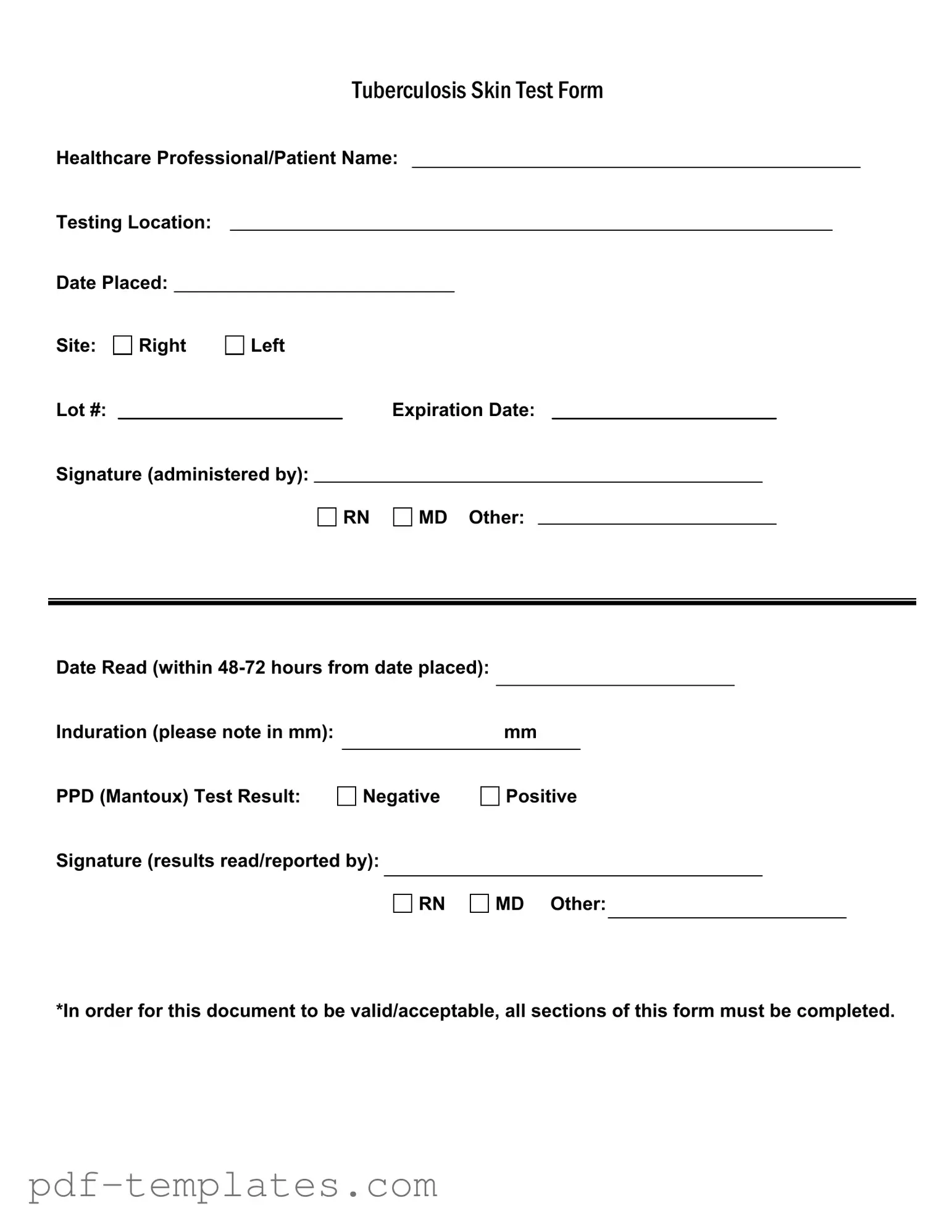The Tuberculosis (TB) Test form shares similarities with the Vaccination Record. Both documents serve as official records of a health-related procedure performed on an individual. They include essential information such as the name of the healthcare professional administering the test or vaccination, the date it was administered, and the results of the procedure. Just as the TB Test form captures the induration measurement and PPD test result, the Vaccination Record documents the type of vaccine given, lot number, and any adverse reactions, ensuring a comprehensive overview of the patient’s immunization history.
Another document that resembles the TB Test form is the Medical Clearance Form. This form is often required for individuals seeking to participate in certain activities, such as sports or employment in healthcare settings. Like the TB Test form, it requires detailed information about the individual’s health status, including any tests conducted and their results. Both documents must be filled out completely to be considered valid, ensuring that all necessary health information is available for review.
The Health History Questionnaire is also similar to the TB Test form. This document collects a patient’s medical history, including previous illnesses, surgeries, and vaccinations. It is essential for healthcare providers to understand a patient's background before administering treatments. Both forms require thorough completion to provide a clear picture of the patient’s health, and they often include sections for signatures from healthcare professionals to validate the information provided.
The Release of Information Form bears resemblance to the TB Test form as well. This document is used to authorize the sharing of medical information between healthcare providers. It typically requires the patient’s name, date of birth, and the specific information being released. Like the TB Test form, it emphasizes the importance of complete and accurate information, as any missing details can hinder the process of obtaining necessary medical records.
Additionally, the Consent for Treatment Form is akin to the TB Test form in that it requires a patient’s consent before a procedure is performed. This document outlines the nature of the treatment and any potential risks involved. Both forms must be signed by the patient or their guardian, ensuring that informed consent is obtained and that the patient understands what the procedure entails.
The Patient Registration Form also parallels the TB Test form. This document collects basic information about the patient, such as name, contact details, and insurance information. It is crucial for establishing a patient’s identity and ensuring that their medical records are accurately maintained. Both forms require comprehensive information to ensure proper treatment and follow-up care.
The Laboratory Test Request Form is another document similar to the TB Test form. This form is used to request specific laboratory tests, including blood tests or cultures. Like the TB Test form, it includes vital information such as the patient's details and the specific tests being requested. Both documents serve to communicate essential health information to healthcare providers, ensuring that the appropriate tests are performed and results are accurately reported.
The importance of accurate documentation in healthcare can be further illustrated by various forms, including the Tuberculosis Skin Test Form and the California Identification Card form. Each document demands thorough information and signatures to ensure validity and compliance with regulations. For those who need to apply for or manage their California identification needs, it's essential to refer to All California Forms for comprehensive guidance and resources.
Lastly, the Health Screening Form is comparable to the TB Test form. This document is often used in various settings to assess an individual’s health status before participating in activities such as school, work, or travel. It typically includes questions about recent illnesses, vaccinations, and any ongoing health issues. Both forms aim to gather pertinent health information to safeguard the well-being of individuals in specific environments.
